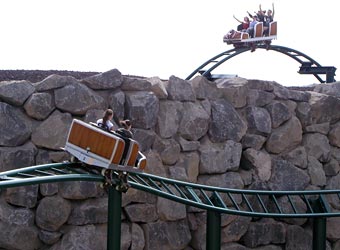|
|
|
The new bear enclosure was the antetype for
the rocky landscape of the coaster |
|
Twelve months later the contract with Gerstlauer was
signed. "We used the time before to find a theme and to
roughly design the layout", Peter Schmitt remembers. "We
had an active brainstorming during quite a few cups of coffee
until we finally had the idea with the volcano." In the
meantime Wendelin Stückl, who exclusively works for
the Gerstlauer company, contributed the first track
layout.
In between Peter Schmitt was involved in the planning of
a new bear enclosure that was designed as a rocky landscape made
of basalt stone. "The stone was delivered by a friend of the
Hennes brothers who owns a quarry nearby", says Peter
Schmitt. "Literally tons of fragments accumulate that
usually are of no use, but we could utilize them for theming the
coaster."
Together with Wendelin Stückl the first draft
layout was re-adjusted. The result was a canyon with up to six
meters high walls the track passes by a hair's breadth. "At
arranging the rocks my former fellow student Michael Lambert
supported us. He joined in in March 2003 because the project grew
too large for my three men office." Even the envisaged log
flume was integrated into the planning of the support structure of
the roller coaster, the foundations and the underground
pipes for water and electrical systems.
 |
|
Helix and stone wall |
|
Our creative work was drastically aggravated by an immense
pressure of time", says Peter Schmitt. "At the
end of February 2003 the contract with Gerstlauer was signed, at
the end of May we received the first usable documents from
Gerstlauer/Stengel [remark: The engineering office Stengel
was responsible for calculating the dynamics and statics as
well as the design of the support structure which was the basis
for the planning group of Schmitt and Lambert to
prepare the foundations], so we filed the building application for
the earthworks in best time. After Gerstlauer had provided all
documents we could file the building application for the buildings
and the coaster itself in July 2003. The construction started at
the height of summer, but we only just received the building
permission for the whole coaster in the middle of November. One
day before St Nicholas' Day the core of the volcano that also
holds most of the support structure of the lift hill was
completed. Praised be the cooperation of our local authorities who
closed all eyes in view of our building activities."
A total of 24 companies and engineering offices was involved in
the largest project in the history of the Wild- und
Freizeitpark Klotten. With the exception of five firms they
all came from the surrounding area, and project manager Peter
Schmitt is very proud of that: "We haven't involved
Polish or other foreign cheap suppliers into the coaster project.
That's private, regional business development ´live´
without any political waffle. And it was the only chance to
resolve the task in such a short time."
Between the start of construction at the height of summer 2003
and the opening on 1 April the following year only nine months
passed by, a very short period of time to convert a 1.2 hectares
cow paddock into a rock landscape. Now only a few spots lie idle
temporarily, but this can´t be avoided during the multiple
years of construction until the final state will be reached. Later
they will be replaced by small lakes that will flank the volcano
with an opulent riverine vegetation.
|
Left: canyon entrance - right: camelbacks
inside the canyon |
|
|
|
"The narrowness of the building site demanded a
sophisticated coordination", says Peter Schmitt. "1.2
hectares may sound pretty much, but the place was crowded all too
soon. There were conflicts between the companies every now and
then, but they all could be solved amicably. The chaos was perfect
when the track elements and supports needed last were delivered
first from Slovenia [remark: The Stakotra company from
Bratislava that produces supports and track for companies like
Intamin, Premier Rides or Zamperla also
delivered the bigger part of the steel components for Klotten].
In Eastern Europe they seem to have a different understanding of
just-in-time delivery - despite detailed freight lists."
For the erecting the supports and fitting in the track elements
the Ride Construction Service of Max Eberhard was
engaged, a company with ample experience in the construction of
roller coasters and other rides. They masterly overcame those
problems, and so the last segment could be put into place two days
before christmas.
 |
|
Stone and steel - an impressive combination |
|
The worst headache for Peter Schmitt and Michael
Lambert was caused by the handling of the basalt stones. 8000
tons were necessary to arrange the landscape that is placed
predominantly in the rear part of the site: "The transport
was the biggest hurdle", Peter Schmitt remembers. "At
the first loads one trailer and several trough containers were
ruined while dumping the stones, so we found no carrier to
transport the stones and to dump them by pouring them out. So we
had to quickly find and rent a second digger with a multi-movable
hydraulic gripper. Those things are pretty rare, so this task was
not too easy." The reward for these efforts is a unique rock
arrangement the cars negotiate in harakiri style. Klotten's roller
coaster is a second Nemesis!
Despite all difficulties and the pressure of time everything
went as planned: On carnival tuesday the ride got the blessing of
TÜV Munich and completed the first test runs without
any problems. Visibly relieved Peter Schmitt and Michael
Lambert took their seats on opening day and enjoyed the "hot
ride" through the volcano. |

